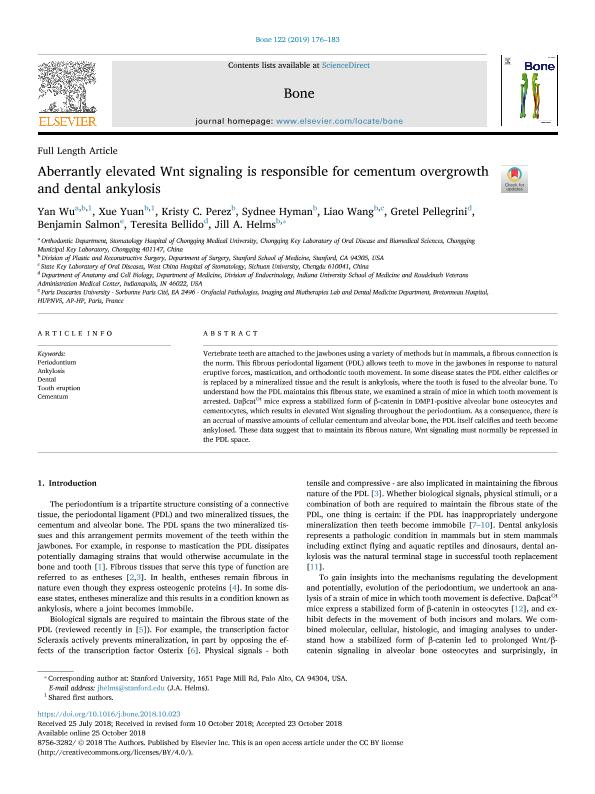Artículo
Aberrantly elevated Wnt signaling is responsible for cementum overgrowth and dental ankylosis
Wu, Yan; Yuan, Xue; Perez, Kristy C.; Hyman, Sydnee; Wang, Liao; Pellegrini, Gretel Gisela ; Salmon, Benjamin; Bellido, Teresita; Helms, Jill A.
; Salmon, Benjamin; Bellido, Teresita; Helms, Jill A.
 ; Salmon, Benjamin; Bellido, Teresita; Helms, Jill A.
; Salmon, Benjamin; Bellido, Teresita; Helms, Jill A.
Fecha de publicación:
05/2019
Editorial:
Elsevier Inc
Revista:
Bone
ISSN:
8756-3282
Idioma:
Inglés
Tipo de recurso:
Artículo publicado
Clasificación temática:
Resumen
Vertebrate teeth are attached to the jawbones using a variety of methods but in mammals, a fibrous connection is the norm. This fibrous periodontal ligament (PDL) allows teeth to move in the jawbones in response to natural eruptive forces, mastication, and orthodontic tooth movement. In some disease states the PDL either calcifies or is replaced by a mineralized tissue and the result is ankylosis, where the tooth is fused to the alveolar bone. To understand how the PDL maintains this fibrous state, we examined a strain of mice in which tooth movement is arrested. DaβcatOt mice express a stabilized form of β-catenin in DMP1-positive alveolar bone osteocytes and cementocytes, which results in elevated Wnt signaling throughout the periodontium. As a consequence, there is an accrual of massive amounts of cellular cementum and alveolar bone, the PDL itself calcifies and teeth become ankylosed. These data suggest that to maintain its fibrous nature, Wnt signaling must normally be repressed in the PDL space.
Palabras clave:
ANKYLOSIS
,
CEMENTUM
,
DENTAL
,
PERIODONTIUM
,
TOOTH ERUPTION
Archivos asociados
Licencia
Identificadores
Colecciones
Articulos(INIGEM)
Articulos de INSTITUTO DE INMUNOLOGIA, GENETICA Y METABOLISMO
Articulos de INSTITUTO DE INMUNOLOGIA, GENETICA Y METABOLISMO
Citación
Wu, Yan; Yuan, Xue; Perez, Kristy C.; Hyman, Sydnee; Wang, Liao; et al.; Aberrantly elevated Wnt signaling is responsible for cementum overgrowth and dental ankylosis; Elsevier Inc; Bone; 122; 5-2019; 176-183
Compartir
Altmétricas



